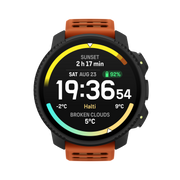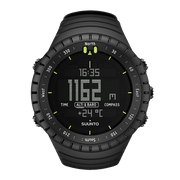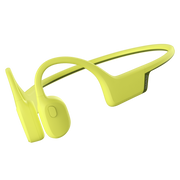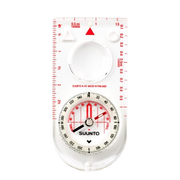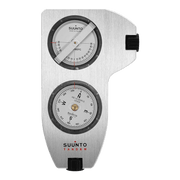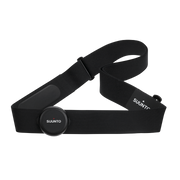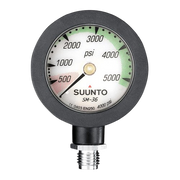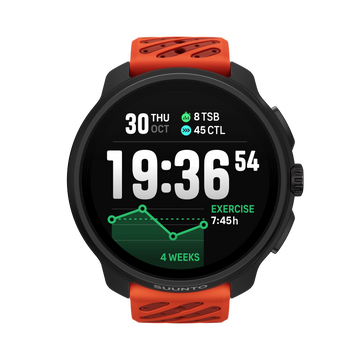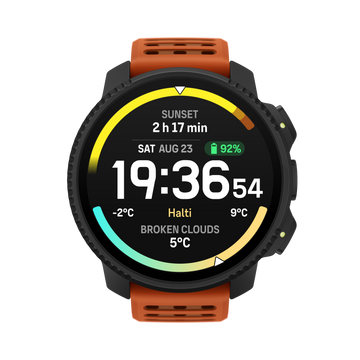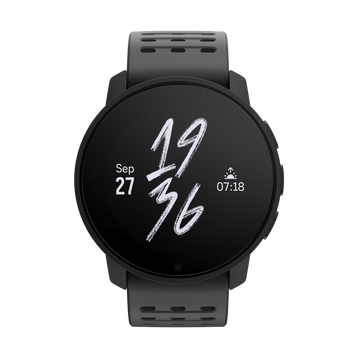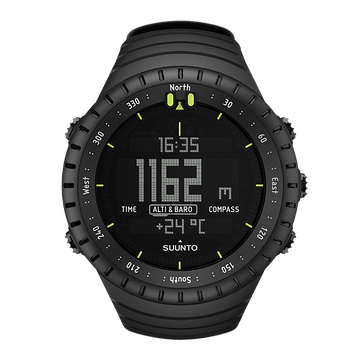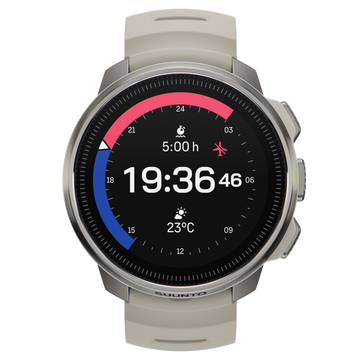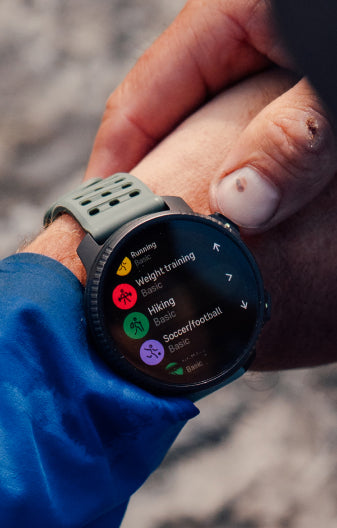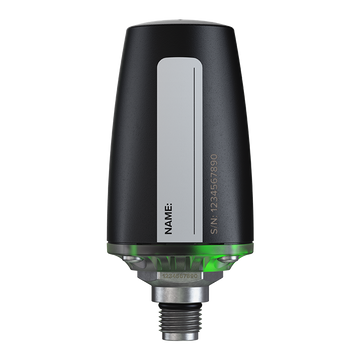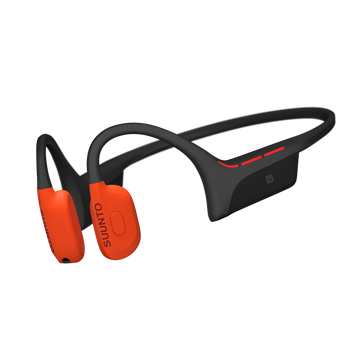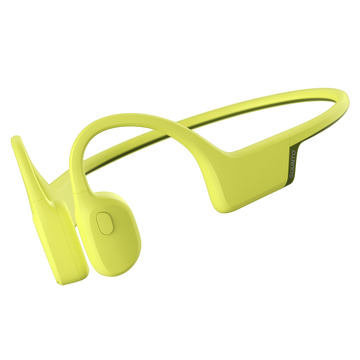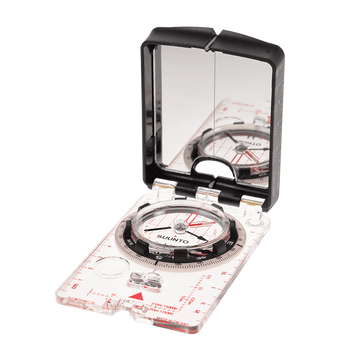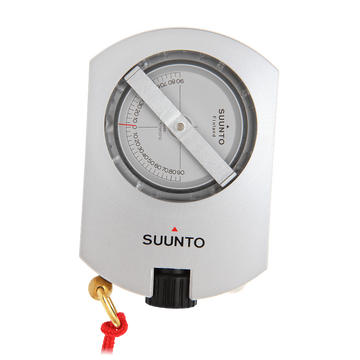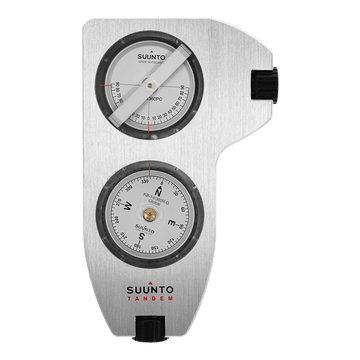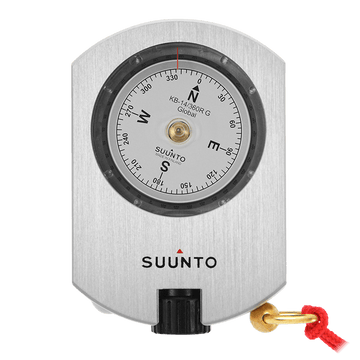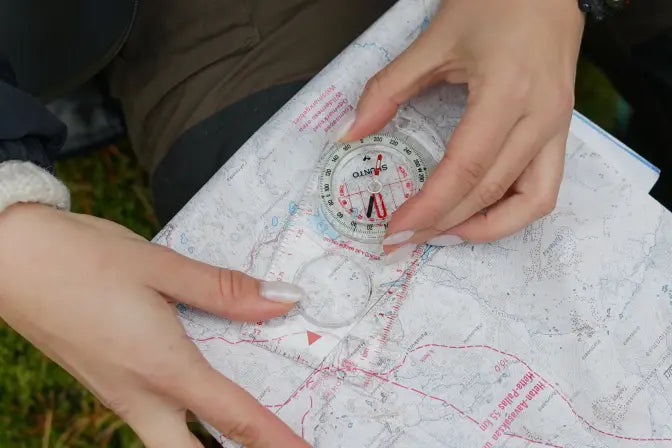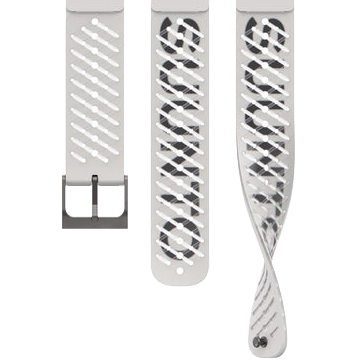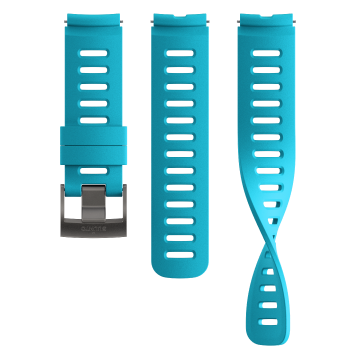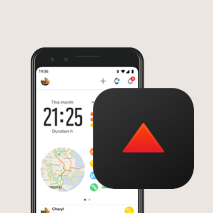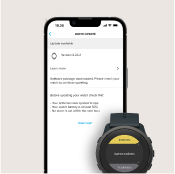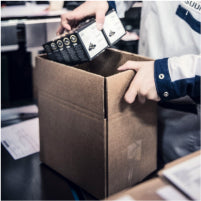If you are doing repetitive dives at an altitude other than the
previous dive altitude, change altitude setting to correspond to
the next dive after the previous dive ended. This ensures more
accurate tissue calculations.
During a dive, the bar on the left indicates ascent rate. One
bar step corresponds to 2 m (6.6 ft) per minute.
When maximum allowed ascent rate is exceeded for five seconds,
an alarm is generated. Ascent rate violations result in longer
safety stop times and mandatory safety stops.
WARNING:
DO NOT EXCEED THE MAXIMUM ASCENT RATE! Rapid ascents increase
the risk of injury. You should always make the mandatory and
recommended safety stops after you have exceeded the maximum
recommended ascent rate. If this mandatory safety stop is not
completed the decompression model will penalize your next
dive(s).
Battery
Suunto EON Steel Black
has a rechargeable lithium-ion battery. Charge the battery by
connecting
Suunto EON Steel Black
to a power source with the included USB cable. As a power
source use either your computer USB port or a wall charger.
The battery icon in the upper left corner of the display shows
the battery status. To the right of the battery icon is the
estimated remaining dive time in hours.
A pop-up message indicates when recharge is needed.

Bookmark
Adding a bookmark (timestamp) to an active log is really easy
in
Suunto EON Steel Black
. See
How to add bookmarks
for the procedure.
Ceiling broken
Algorithm lock
This section describes what happens if you break the
decompression ceiling when diving with Suunto Fused™ RGBM 2
algorithm.
Breaking the decompression ceiling
When you ascend above the ceiling by more than 0.6 m (2 ft),
the ceiling parameter turns red, a red, down pointing arrow
appears, and an audio alarm is generated.

In such event, you should descend below the ceiling level to
continue the decompression. If you fail to do so within three
(3) minutes,
Suunto EON Steel Black
locks the algorithm calculation and displays
Locked
instead, as shown below. Note that the ceiling value is no
longer present.

In this state, you significantly increase your risk of
decompression sickness (DCS). Decompression information is not
available for the next 48 hours after surfacing.
Algorithm locked
Locking the algorithm is a safety feature, highlighting that
the algorithm information is no longer valid.
It is possible to dive with the device when the algorithm is
locked, but instead of the decompression information,
Locked
is shown. Diving while the algorithm is locked resets the
algorithm lock time back to 48 hours when you surface.
NOTE:
When you dive with Bühlmann 16 GF algorithm, the algorithm
will not be locked even if you break the decompression
ceiling and omit the decompression stops. See
Warning: Ceiling broken
for more information.
Warning: Ceiling broken
This section describes what happens if you break the
decompression ceiling when diving with Bühlmann 16 GF
algorithm.
Bühlmann 16 GF algorithm does not have the same algorithm lock
as the one in Suunto Fused™ RGBM 2 algorithm. If you dive
with Bühlmann 16 GF algorithm, your device will continue
showing the original dive plan even if the decompression stop
is violated. Approve the
Ceiling broken
warning by pushing the middle button.

When the warning disappears,
Ceiling broken
sign becomes visible on the left side of the screen.

Logs
If ceiling is broken during your dive, it will be visible in
your dive logs. When you check the dive in numeric view,
Ceiling broken
is shown as a header of the log.

If you dive again after ceiling was broken, the new dive log
has the header
Ceiling broken in previous dive
.

Dive planner
If ceiling is broken during your dive, it will be visible in
the Dive planner. A pop-up message appears on the screen,
saying
Prior Ceiling Broken violation will affect planner accuracy
. The message disappears after three seconds or it can be
removed by pushing the middle button. After the message
disappears, the planner can be used as usual.
Clock
Suunto EON Steel Black
's time and date settings are found under
Device settings
.
Time and date formats are found under
Units & formats
. For setting, see
How to set time and date
.
Compass
Suunto EON Steel Black
includes a tilt-compensated digital compass, available as a
main view.

Calibrating compass
When you first start using
Suunto EON Steel Black
, and after each charging, the compass needs to be calibrated
and it is required to do so to activate it.
Suunto EON Steel Black
displays the calibration icon when you enter the compass view.
During the calibration process, the compass adjusts itself to
the surrounding magnetic field.
Because of changes in the surrounding magnetic field, it is
recommended to re-calibrate the compass before each dive.
To manually start calibration:
-
Take off your
Suunto EON Steel Black
.
- Keep the middle button pressed to enter the menu.
-
Browse to
General
»
Compass
.
-
Press the middle button to enter
Compass
.
-
Scroll up or down to select
Calibrate
.
-
Start calibrating the device by trying to move it around the
xyz axes of the coordinate system (like you were drawing a
small circle) so that the magnetic field is as stable as
possible during the calibration. To achieve this, try to
keep
Suunto EON Steel Black
in the same location and do not move it around using large
movements.
-
Repeat the rotation until the compass calibration is
successful.

-
A sound indicates when the calibration succeeded, and the
screen goes back to
Compass
menu.
NOTE:
If the calibration fails several times in a row, you may be
in an area with strong sources of magnetism, such as large
metal objects. Move to another location and try to calibrate
the compass again.
Setting declination
You should always adjust your compass declination for the area
where you are diving to get accurate heading readings. Check
the local declination from a trusted source and set the value
in
Suunto EON Steel Black
.
To set declination:
- Keep the middle button pressed to enter the menu.
-
Browse to
General
»
Compass
.
-
Press the middle button to enter
Compass
.
-
Press the middle button again to enter
Declination
.
-
Scroll up/down to set the angle of declination: Starting
from 0.0º scroll up towards East or down towards West
declination. To turn declination off, set declination angle
to 0.0º.
-
Press middle button to save changes and go back to the
Compass
menu.
- Keep the middle button pressed to exit.
Locking the bearing
A bearing is the angle between north and your target. In
simple terms, it is the direction you want to travel. Your
heading, on the other hand, is your actual direction of
travel.
You can set a bearing lock to help you orientate yourself
underwater and ensure you maintain your direction of travel.
For example, you can set a bearing lock for the direction to
the reef before leaving the boat.
You can reset the bearing lock at any time, but you can only
clear a bearing lock while at the surface.
To set a bearing lock:
-
Press the middle button to change to the compass view.
-
Hold your
Suunto EON Steel Black
in level in front of you, with the top pointing in the
direction to your target.
-
Keep the lower button pressed until you see the
Bearing locked
notification.

Once you have a bearing locked, the lock position is indicated
on the compass rose, as shown below.

Below your heading (large number in center of compass), you
also see the relative difference between your bearing and your
heading. So, for instance, when you want to travel in the
exact direction of your bearing, the lower number should be
0°.
If you want to set a new bearing lock, just repeat the same
procedure above. Each bearing lock is recorded in your dive
log with a time stamp.
To clear the bearing lock from your compass view, you need to
return to the surface.
To clear a bearing lock:
-
While in surface state, keep the middle button pressed to
enter the main menu.
-
Scroll to
General
with the upper or lower buttons and press the middle button.
-
Press the middle button to enter
Compass
.
-
Select
Clear bearing
with the middle button.
- Keep the middle button pressed to exit.
Customizing dive modes with Suunto app
You can easily customize device and dive settings, such as
dive modes and views with Suunto app. Create up to 10
different dive modes with up to four custom views each.
You can customize the following:
- Dive mode name
- Settings (e.g., personal setting, views, gases)
See
How to customize dive modes with Suunto app
for more information.
Decompression algorithms
Suunto's decompression model development originates from the
1980s when Suunto implemented Bühlmann's model based on
M-values in Suunto SME. Since then research and development
has been ongoing with the help of both external and internal
experts.
In the late 1990s, Suunto implemented Dr. Bruce Wienke's RGBM
(Reduced Gradient Bubble Model) to work with the earlier
M-value based model. The first commercial products with the
feature were the iconic Suunto Vyper and Suunto Stinger. With
these products the improvement of diver safety was significant
as they addressed a number of diving circumstances outside the
range of dissolved-gas-only models by:
- Monitoring continuous multiday diving
- Computing closely spaced repetitive diving
- Reacting to a dive deeper than the previous dive
-
Adapting to rapid ascents which produce high microbubble
(silent-bubble) build-up
-
Incorporating consistency with real physical laws for gas
kinetics
Suunto EON Steel Black
has two decompression algorithms available: Suunto Fused™
RGBM 2 algorithm and Bühlmann 16 GF algorithm. Choose the
appropriate algorithm for your dive under
Dive settings
»
Parameters
»
Algorithm
.
NOTE:
All decompression models are theoretical and have their
benefits and limitations. When you choose the appropriate
decompression algorithm and personal setting or gradient
factors for your dive, always take your personal factors,
the planned dive, and your dive training into consideration.
NOTE:
Although it is possible, changing the algorithm between
dives is not recommended when no-fly time calculation is
active.
NOTE:
Make sure your Suunto dive computer always has the latest
software with updates and improvements. Check before every
dive trip from support, if Suunto has released a new
software update for your device. When a new software update
is available, you must install it before diving. Updates are
made available to improve your user experience and are part
of Suunto's philosophy of continuous product development and
improvement.
Suunto Fused™ RGBM 2 algorithm
The Suunto Fused™ RGBM 2 combines and improves widely
respected Suunto RGBM and Suunto Fused™ RGBM decompression
models developed by Suunto together with Dr. Bruce Wienke.
(Suunto dive algorithms are a culmination of expertise and
knowledge accumulated over decades of development, testing and
thousands upon thousands of dives.)
In Suunto Fused™ RGBM 2 the tissue half-times are derived
from Wienke’s Full RGBM where human body is modeled by fifteen
different tissue groups. Full RGBM can utilize these
additional tissues and model the on-gassing and off-gassing
more accurately. The amounts of nitrogen and helium on-gassing
and off-gassing in the tissues are calculated independently
from each other.
Suunto Fused™ RGBM 2 algorithm supports open-circuit and
closed-circuit diving up to a depth of 150 meters. Compared to
previous algorithms, Suunto Fused™ RGBM 2 is less
conservative on deep air dives, allowing shorter ascent times
during decompression dives. In addition, the algorithm no
longer requires tissues to be completely free of residual
gases when calculating no-fly times, thereby reducing the
required time between your last dive and flying.
The advantage of Suunto Fused™ RGBM 2 is additional safety
through its ability to adapt to a wide variety of situations.
For recreational divers it may offer slightly longer no- deco
times, depending on the chosen personal setting. For
open-circuit technical divers it allows use of gas mixes with
helium - on deeper and longer dives helium based gas mixes
provide shorter ascent times. And finally, for rebreather
divers the Suunto Fused™ RGBM 2 algorithm gives the perfect
tool to be used as a non-monitoring, set point dive computer.
NOTE:
Suunto EON Steel devices with software version earlier than
2.0 use Suunto Fused™ RGBM algorithm. Once updated to the
latest software, Suunto Fused™ RGBM 2 will be installed to
the dive computer.
Bühlmann 16 GF algorithm
The Bühlmann decompression algorithm was developed by Swiss
physician Dr. Albert A. Bühlmann, who researched into
decompression theory starting from 1959. The Bühlmann
decompression algorithm is a theoretical mathematical model
describing the way in which inert gases enter and leave the
human body as the ambient pressure changes. Several versions
of the Bühlmann algorithm have been developed over the years
and adopted by many dive computer manufacturers. Suunto’s
Bühlmann 16 GF dive algorithm is based on the model ZHL-16C.
This model has 16 different theoretical tissue groups with
half times from 4 minutes up to 635 minutes.
Gradient factors
Gradient Factor (GF) is a parameter which is used only with
the Bühlmann dive algorithm. GFs are a way to add conservatism
to the Bühlmann algorithm by adding deepstops to the dive. GFs
are divided into two separate parameters, Gradient Factor Low
and Gradient Factor High. By using GF with the Bühlmann
algorithm you can set your safety margin for the dive by
adding conservatism to control when different tissue
compartments reach their acceptable M‑value.
Gradient factors are always defined as percentages. The Low %
value determines the first deepstop, while the High % value
defines the allowed M-value once surfacing. Using this method,
the GF changes throughout the ascent.
A commonly used combination is GF Low 30% and GF High 70%.
(Also written as GF 30/70.) This setting means that the first
stop would take place once the leading tissue reaches 30% of
its M-value. The lower the first number is, the less
supersaturation is allowed. As a result, the first stop is
required when you are deeper. In the following illustration,
GF Low is set to 30% and the leading tissue compartments react
to the 30% limit of M-value. At this depth the first
decompression stop takes place.

When the ascent continues, the GF moves from 30% to 70%. GF 70
indicates the amount of supersaturation allowed when you get
to the surface. The lower the GF High value is, the longer
shallow stop is needed in order to off-gas before surfacing.
In the following illustration, GF High is set to 70% and the
leading tissue compartments react to the 70% limit of M-value.
At this point you can come back to the surface and finish your
dive.

The default setting of Suunto's Bühlmann 16 GF dive algorithm
is 30/70. All values other than the default values are out of
recommendation. If you modify the default values, the value
number turns red and a warning appears on the screen.

WARNING:
Do not edit gradient factor values until you understand the
effects. Some gradient factor settings can cause a high risk
of DCS or other personal injury.
The effects of gradient factors on the dive profile
GF Low % effect on dive profile is illustrated in the
following picture. It shows how GF Low % determines the depth
where the ascent starts slowing down and the depth of the
first decompression stop. The illustration shows how the
different GF Low % values change the depth of the first stop.
The higher the GF Low % value is, the shallower the first stop
occurs.

NOTE:
If GF Low % value is too low, some tissues may still on-gas
when the first stop occurs.
GF High % effect on the dive profile is illustrated in the
following picture. It shows how GF High % determines the
decompression time spent in the shallow phase of the dive. The
higher the GF High % value is, the shorter the total dive time
is, and the less time diver spend in shallow water. If GF High
% is set to a lower value, the diver spends more time in
shallow water and total dive time gets longer.

If you want to see the comparison of the Suunto Fused™ RGBM 2
algorithm and the Bühlmann 16 GF algorithm, go to
suunto.com/support
.
Diver safety
Because any decompression model is purely theoretical and does
not monitor the actual body of a diver, no decompression model
can guarantee the absence of DCS.
CAUTION:
Always use the same personal and altitude adjustment
settings for the actual dive and for the planning.
Increasing the personal adjustment setting from the planned
setting as well as increasing the altitude adjustment
setting can lead to longer decompression times deeper and
thus to larger required gas volume. You can run out of
breathing gas underwater if the personal adjustment setting
has been changed after dive planning.
Oxygen exposure
The oxygen exposure calculations are based on currently
accepted exposure time limit tables and principles. In
addition to this, the dive computer uses several methods to
conservatively estimate the oxygen exposure. For example:
-
The displayed oxygen exposure calculations are raised to the
next higher percentage value.
-
The CNS% limits up to 1.6 bar (23.2 psi) are based on 1991
NOAA Diving Manual limits.
-
The OTU monitoring is based on the long-term daily tolerance
level and the recovery rate is reduced.
Oxygen related information displayed by the dive computer is
also designed to ensure that all warnings and displays occur
at the appropriate phases of a dive. For example, the
following information is provided before and during a dive
when the computer is set to Air/Nitrox or Trimix (if helium is
activated in use):
-
The selected O
2
% (and possible helium %)
-
CNS% and OTU (visible only after your customization in
Suunto app)
-
Audible notification when CNS% reaches 80%, then warning
when 100% limit is exceeded
-
Notification when OTU reaches 250 and then warning when 300
limit is exceeded
-
Audible alarm when pO
2
value exceeds the preset limit (pO
2
high alarm)
-
Audible alarm when pO
2
value is < 0.18 (pO
2
low alarm)
WARNING:
WHEN THE OXYGEN LIMIT FRACTION INDICATES THAT THE MAXIMUM
LIMIT IS REACHED, YOU MUST IMMEDIATELY TAKE ACTION TO REDUCE
OXYGEN EXPOSURE. Failure to take action to reduce oxygen
exposure after a CNS%/OTU warning is given can rapidly
increase the risk of oxygen toxicity, injury, or death.
Decompression dives
When on a decompression (deco) dive you exceed the no
decompression limit,
Suunto EON Steel Black
provides the decompression information required for ascent.
Ascent information is always presented with two values:
-
ceiling
: depth that you should not go above
-
asc. time
: optimum ascent time in minutes to surface with given
gases
WARNING:
NEVER ASCEND ABOVE THE CEILING! You must not ascend above
the ceiling during your decompression. In order to avoid
doing so by accident, you should stay somewhat below the
ceiling.
On a decompression dive, there can be three kinds of stops:
-
Safety stop
: this is a recommended three-minute stop for every dive
over 10 meters (33 ft).
-
Deepstop
: this is a recommended stop when you dive deeper than 20
m (66 ft).
-
Decompression stop
: this is a compulsory stop on your decompression dive
that is for your safety, preventing decompression
sickness.
In
Dive settings
»
Parameters
, you can
- turn deepstops on or off (it is on by default)
-
adjust the safety stop time to be 3, 4 or 5 minutes
(default is 3 minutes)
-
set last stop depth to 3.0 m or 6.0 m (default is 3.0 m)
The following illustration shows a decompression dive where
the ceiling is at 17.7 m (58 ft):

From bottom to top you see the following in the above image:
-
There is a decompression window (
Deco window
) that is the distance between the decompression ceiling
(
Deco ceiling
) plus 3.0 m (9.8 ft) and the decompression ceiling. So
the decom window in this example is between 20.7 m (68
ft) and 17.7 m (58 ft). This is the area where
decompression takes place. The closer to the ceiling you
stay, the more optimal the decompression time is.
When you ascend close to the ceiling depth and enter the
deco window area, two arrows appear in front of the
ceiling depth value. The downward and upward pointing
white arrows indicate that you are within the deco
window.
-
If you ascend above the ceiling depth, there is still a
safe margin area, equaling to ceiling depth minus 0.6
meters (2 ft). So in this example, it is between 17.7 m
(58 ft) and 17.1 m (56 ft). In this safe margin area,
decompression calculation still continues, but you are
advised to go down below the ceiling depth. This is
indicated by the ceiling depth number turning yellow
with a downward pointing yellow arrow in front of it.
-
If you go above the safe margin area, the decompression
calculation is paused until you go back down below this
limit. An audible alarm and a downward pointing red
arrow in front of the ceiling depth value indicate
unsafe decompression.
If you ignore the alarm and stay above the safe margin
for three minutes,
Suunto EON Steel Black
locks the algorithm calculation, and decompression
information will not be available anymore on the dive.
See
Algorithm lock
.
Decompression display examples
Suunto EON Steel Black
shows the ceiling value always from the deepest of these
stops.
In the below display, the ceiling depth is set to 17.1 m and
the diver is currently at 17.1 m. White arrows beside the
ceiling depth value show the diver is inside the
decompression window.

The following example shows that the decompression ceiling
depth is at 15.2 m and diver is at 14.7 m. Diver is still
inside the decompression window but above the optimal limit.
A yellow downward pointing arrow indicates the diver is
recommended to descend to be at optimal depth.

The following example shows that the decompression ceiling
depth is at 12.4 m and diver is at 11.0 m. The diver is
outside of the decompression window and must descend. A red
arrow and an alarm sound prompt the diver to dive deeper and
the ceiling depth is indicated in red.

NOTE:
When you dive with the Suunto Fused™ RGBM 2 algorithm and
the ceiling is broken for more than 3 minutes, the
decompression algorithm gets locked.
With decompression stops, in the continuous ascent mode the
ceiling is constantly decreasing while you are near the
ceiling depth, providing continuous decompression with
optimum ascent time. While in the stepped ascent mode, the
ceiling is the same for a specific time and then moves
upwards 3 m (9.8 ft) at a time.
NOTE:
It is always recommended to keep close to the
decompression ceiling when ascending.
Ascent time is always the minimum time needed to reach the
surface. It includes:
- Time required for deepstops
- Ascent time from depth at 10 m (33.0 ft) per minute
- Time needed for decompression
WARNING:
When diving with multiple gases, remember that the ascent
time is always calculated with the assumption that you use
all the gases found in the Gases menu. Always check that
you have only the gases for your current planned dive
defined before you dive. Remove the gases that are not
available for the dive.
WARNING:
YOUR ACTUAL ASCENT TIME MAY BE LONGER THAN DISPLAYED BY
THE DIVE COMPUTER! The ascent time will increase if you:
(1) remain at depth, (2) ascend slower than 10 m/min (33
ft/min), (3) make your decompression stop deeper than at
the ceiling, and/or (4) forget to change the used gas
mixture. These factors might also increase the amount of
breathing gas required to reach the surface.
Last stop depth
You can adjust the last stop depth for decompression dives
under
Dive settings
»
Parameters
»
Last stop depth
. There are two options: 3 m and 6 m (9.8 ft and 19.6 ft).
By default, the last stop depth is 3 m (9.8 ft). This is the
recommended last stop depth.
NOTE:
This setting does not affect the ceiling depth on a
decompression dive. The last ceiling depth is always 3 m
(9.8 ft).
TIP:
Consider setting the last stop depth to 6 m (19.6 ft) when
you dive in rough sea conditions and stopping at 3 m (9.8
ft) is challenging.
Deco profile
Deco profile can be selected in
Dive settings
»
Parameters
»
Deco profile
.
Continuous decompression profile
Traditionally, since Haldane’s 1908 tables, decompression
stops have always been deployed in fixed steps such as 15
m, 12 m, 9 m, 6 m and 3 m. This practical method was
introduced before the advent of dive computers. However,
when ascending, a diver actually decompresses in a series
of more gradual ministeps, effectively creating a smooth
decompression curve.
The advent of microprocessors has allowed Suunto to more
accurately model the actual decompression behavior. A
continuous decompression curve is included in the Suunto
Fused™ RGBM 2's working assumption.
During any ascent involving decompression stops, Suunto
dive computers calculate the point at which the control
compartment crosses the ambient pressure line (that is the
point at which the tissue’s pressure is greater than the
ambient pressure), and off-gassing starts. This is
referred to as the decompression floor. Above this floor
depth and below the ceiling depth is the decompression
window. The range of the decompression window is dependent
on the dive profile.
Off-gassing in the leading fast tissues will be slow at or
near the floor because the outward gradient is small.
Slower tissues may be still on-gassing and given enough
time, the decompression obligation may increase, in which
case the ceiling may move down and the floor may move up.
Suunto RGBMs optimize these two contradictory issues
through a combination of a slow ascent rate and continuous
decompression curve. It all comes down to proper control
of the expanding gas during an ascent. This is why all
Suunto RGBMs use a maximum ascent rate at 10 m/minute,
which has proven over the years to be an effective
protective measure.
The decompression floor represents the point at which the
Suunto RGBM is seeking to maximize bubble compression,
while the decompression ceiling is maximizing off-gassing.
The added advantage of having a decompression ceiling and
floor is that it recognizes that in rough water, it might
be difficult to maintain the exact depth to optimize
decompression. By maintaining a depth below the ceiling
but above the floor, the diver is still decompressing,
although slower than optimal, and provides an additional
buffer to minimize the risk that waves will lift the diver
above the ceiling. Also, the continuous decompression
curve used by Suunto provides a much smoother and a more
natural decompression profile than the traditional “step”
decompression.
Suunto EON Steel Black
has a feature of displaying the decompression ceiling. The
optimal decompression occurs in the decompression window,
which is displayed by both upward and downward arrows. If
the ceiling depth is violated, a downward pointing arrow
and an audible alarm will prompt the diver to descend back
to the decompression window.
Stepped decompression profile
In this decompression profile the ascent has divided into
traditional 3 m (10 ft) steps or stages. In this model
diver will decompress at traditional fixed depths.

NOTE:
Decompression profile selection is available for EON
Steel Black devices and EON Steel devices with software
update 2.5.
Device info
Information about your
Suunto EON Steel Black
can be found in your device. This information includes
device name, serial number, software and hardware
versions and radio compliance information. See
How to access device info
.
Display
Display LED backlight is always on when the device is
active. It cannot be turned off, but you can turn the
display brightness down to extend battery life
significantly.
For display brightness adjustment, see
How to change display brightness
.
Dive history
Dive history is a summary of all the dives done with
your
Suunto EON Steel Black
. The history is divided according to the dive type used
for the dive. Each dive type summary includes the number
of dives, cumulative dive hours and maximum depth. Enter
History under
General
»
About EON
:

NOTE:
If there is more history information available than
can be shown in a single screen, you can scroll
through the additional information with the upper and
lower buttons.
Dive modes
By default,
Suunto EON Steel Black
has four dive modes: Air/Nitrox, Trimix, CCR and Gauge
(bottom timer). Select the appropriate mode for your
dive under
Dive settings
»
Mode
.

NOTE:
Suunto EON Steel Black
shows all dive mode names in English. You can change
dive mode names via Suunto app.
NOTE:
All dive modes are by default in classic view style.
You can change this and other settings, as well as
set new views and create additional dive modes using
Suunto app.
In Suunto app you can create new or edit existing dive
modes, modify screen layouts, change helium and
multi-gas settings, and change dive type (OC/CC).
Air/Nitrox mode
By default,
Air/Nitrox
mode is for diving with regular air and diving with
oxygen enriched gas mixtures.
Diving with nitrox gas mixture allows you to increase
bottom times or reduce the risk of decompression
illness.
Suunto EON Steel Black
provides you with information to adjust your dive and
stay within safe limits.
When diving with nitrox gas mixture, both the
percentage of oxygen in your tank and the oxygen
partial pressure limit must be entered into
Suunto EON Steel Black
. This ensures correct nitrogen and oxygen
calculations and the correct maximum operating depth
(MOD), which is based on your entered values. The
default oxygen percentage (O
2
%) setting is 21% (air) and oxygen partial pressure
(pO
2
) setting is 1.6 bar (23 psi).
NOTE:
When diving with a nitrox gas mixture, Suunto
recommends changing the partial pressure to 1.4 bar
(20 psi).
Air/Nitrox has two views by default:
-
No deco

-
Compass

NOTE:
Air/Nitrox dive mode has one active gas by default.
You can edit this gas in the device menu where O
2
percentage and pO
2
value can be changed. To enable diving with more
than one gas, you need to activate multi-gas diving
under
Dive settings
»
Parameters
»
Multiple gases
. After this step you are able to add further gases
in the
Gases
menu. Gas settings can also be customized in Suunto
app.
Trimix mode
Trimix
dive mode is for diving with a breathing gas
consisting of oxygen, nitrogen and helium. With helium
added, you can create gas mixtures optimal for your
dive.
Trimix mode is typically for deep dives with extended
dive time.
Trimix mode has two views by default:
-
No deco

-
Compass

NOTE:
In Trimix mode,
Suunto EON Steel Black
has the multiple gases option automatically turned
on.
NOTE:
When diving with helium activated, deepstop is on by
default, and it cannot be turned off.
CCR mode
CCR
is a dive mode dedicated to rebreather diving.
When you select CCR mode, your device will have two
different gas menus:
CC gases
(closed-circuit gases) and
OC gases
(open-circuit gases). For more information on diving
in CCR mode, see
Rebreather diving
.
CCR mode has two views by default
-
No deco

-
Compass

NOTE:
When diving with helium activated, deepstop is on by
default, and it cannot be turned off.
Gauge mode
Use
Suunto EON Steel Black
as a bottom timer with
Gauge
.
Gauge mode is a bottom timer only. It does not use any
decompression algorithm, thus it does not include
decompression information or calculations.
Gauge mode has two views by default.
-
Timer

-
Compass

NOTE:
After diving in Gauge mode, decompression
calculation is locked for 48 hours. If during this
time you dive again in Air/Nitrox, Trimix or CCR
mode, the dive algorithm and the decompression
calculation will not be available and
Locked
will be shown on the screen
NOTE:
Locked time is set back to 48 hours if you start a
new dive while your device is locked.
Dive planner
The dive planner in
Suunto EON Steel Black
helps you to quickly plan your next dive. The
planner displays available no decompression time and
gas times for your dive based on depth, tank size
and gas consumption set.
The dive planner can also help you plan dives in
series, taking into account the residual nitrogen
from your previous dive(s) based on the planned
surface time you enter.
NOTE:
It is important to adjust tank size, tank pressure
and personal gas consumption to get the gas
calculations right.
See
How to plan a dive using the Dive planner
for details on planning your dives.
Enriched Air Nitrox diving use
This device can be used with nitrox breathing gases
(also known as oxy-nitrogen).
WARNING:
Do not use nitrox gas mixtures if you do not have
proper training. Appropriate training courses
about nitrox and oxygen diving are essential prior
to the use of this kind of equipment with oxygen
content greater than 22%.
WARNING:
In nitrox use, the maximum operating depth and
exposure time are dependent on the oxygen content
of the gas.
WARNING:
There is a danger when using nitrox that
contaminants may give rise to an oxygen ignition.
WARNING:
The use of breathable air according to EN 12021
may contaminate the diving apparatus.
NOTE:
To minimize the risk of oxygen ignition, always
open the pressure valve(s) slowly.
For information on Nitrox diving with Suunto Tank
POD, see Suunto Tank POD Safety and Regulatory
Information delivered with your Tank POD or
available at
SuuntoTankPodSafety
.
Flip display
You can flip the display of
Suunto EON Steel Black
to have the buttons on either the left or right side
of the dive computer, making it easier to wear on
either arm.
Change the button orientation under
General
»
Device settings
»
Flip display
.
Select
Buttons right
to have the buttons on the right-hand side or
Buttons left
to have them on the left-hand side.
Gas consumption
Gas consumption refers to your real-time consumption
rate of gas during a dive. In other words, it is the
amount of gas a diver would use in one minute on the
surface. This is commonly known as your surface air
consumption or SAC rate.
Gas consumption rate is measured in liters per
minute (cubic feet per minute). This is an optional
field and needs to be added to your custom dive mode
views in Suunto app. In the classic view below, gas
consumption rate is in the bottom right corner.

For enabling gas consumption metering, see
How to enable gas consumption metering
.
Gas mixtures
By default,
Suunto EON Steel Black
has only one gas (air) available. The default oxygen
percentage (O
2
%) setting is 21% (air) and oxygen partial pressure
(pO
2
) setting is 1.6 bar (23 psi). You can modify O
2
percentage and pO
2
settings in
Gases
menu.
NOTE:
When diving with a nitrox gas mixture, Suunto
recommends changing the partial pressure to 1.4
bar (20 psi).
If you are diving with only one gas, ensure you have
only that one gas in the
Gases
menu. Otherwise,
Suunto EON Steel Black
expects you to use all gases in the list and
notifies you to change gases during the dive.
If you need more than one gas, activate multi-gas
option in your device. Go to
Dive settings
»
Parameters
and turn on
Multiple gases
option.
You need to define all gas mixtures intended to use
during the dive in the
Gases
menu because during your dive the decompression
algorithm calculates ascent time using all gases
available in the
Gases
menu.
If you want to use trimix gas mixtures (with helium
activated), you need to turn helium on under
Dive settings
»
Parameters
. When this is done, you can change helium
percentage (He%) for the selected gas in the
Gases
menu.
You can activate multi-gas diving and helium,
configure dive modes and change gas settings using
Suunto app, too.
Changing gas during a dive
It is important to understand how your
Suunto EON Steel Black
device works when you dive with multiple gases. For
example, you may have the following gases when
diving to 55 m (180.5 ft):
-
tx18/45, MOD 62.2 m (pO
2
1.3)
-
tx50/10, MOD 22 m (pO
2
1.6)
- Nx99, MOD 6 m
While ascending, you are notified to change gas at
22 m (72 ft) and 6 m (20 ft) according to the
maximum operating depth (MOD) of the gas. To take a
better gas into use, you need to change gas manually
by completing the following steps:
-
Press any button to acknowledge the gas change
notification.
-
Long press the middle button to see gas options.
-
Scroll with the upper or lower buttons to the
desired gas.
-
Press the middle button to confirm gas selection.
NOTE:
If you press any button while
Change gas
notification is visible on the device screen, the
notification disappears. By pressing a button, you
only confirm the notification, but gas is not
changed automatically. You should always change
gas manually. To change gas, you must follow the
above listed steps.
NOTE:
When you select CCR, gas mixtures are divided to
open-circuit and closed-circuit gases. See
Rebreather diving
.
Modifying gases during a dive
Modifying the gas list in your device is for
emergency cases only. For example, due to unforeseen
events, you might lose a gas mixture, in which case
you could adjust to the situation by deleting that
gas mixture from the gas list of
Suunto EON Steel Black
. This allows you to continue diving and get correct
decompression information calculated by the dive
computer.
In another case, if for some reason you run out of
gas and need to use a gas mixture from a dive buddy,
it is possible to adapt
Suunto EON Steel Black
to the situation by adding the new gas mixture to
the list.
Suunto EON Steel Black
re-calculates decompression and shows the correct
information.
NOTE:
This feature is not enabled by default, it must be
activated and it creates an additional step to the
gas menu during the dive. It is only available if
multiple gases are selected for the dive mode.
To enable modifying gases, turn the feature on in
the settings menu under
Dive settings
»
Parameters
»
Modify gases
.
When enabled, during a multi-gas dive, you can add a
new gas as well as select an existing gas from the
gas list to remove it.
NOTE:
You cannot modify or remove the gas currently in
use (active gas).
When
Modify gases
is turned on, you can remove gases which are not in
use from the gas list, add new gases to the list,
and modify parameters (O
2
, He, pO
2
) of nonactive gases.
Isobaric counterdiffusion (ICD)
Isobaric counterdiffusion (ICD) occurs when
different inert gases (such as nitrogen and helium)
diffuse in different directions during a dive. In
other words, one gas is being absorbed by the body
while the other is being released. ICD is a risk
when diving with trimix mixtures.
This may happen during a dive, for example, when
trimix gas is switched to nitrox or light trimix.
When the switch is made, helium and nitrogen rapidly
diffuse in opposite directions. This produces a
transient increase in total inert gas pressure which
can lead to decompression sickness (DCS).
Currently there are no algorithms that can address
ICD. Therefore, you need to take it into account
when planning trimix dives.
You can use
Suunto EON Steel Black
to plan your trimix usage safely. Under the
Gases
menu, you can adjust oxygen (O
2
) and helium (He) percentages to see the change in
partial pressure of nitrogen (ppN2) and the partial
pressure of helium (ppHe) values.
An increase in partial pressure is indicated by a
positive number, and a decrease by a negative
number. The changes in ppN2 and ppHe are displayed
next to each gas mixture that you want to switch to.
Maximum operating depth (MOD) of a breathing gas is
the depth at which the partial pressure of oxygen
(pO
2
) of the gas mix exceeds a safe limit. You can
define pO
2
limit for the gas.
An ICD warning is generated when:
-
Gas switch depth is greater than 10 m (33 ft).
-
Geometric mean of the partial pressure change of
N2 and partial pressure change of He is bigger
than 0.35 bar.
If these limits are exceeded with a gas switch,
Suunto EON Steel Black
indicates the risk of ICD as shown below:

In this example, the available gas mixtures for a
deep trimix dive are:
-
Trimix 15/55, MOD 76.7 m (pO
2
1.3)
-
Trimix 35/15, MOD 27.1 m (pO
2
1.3)
-
Trimix 50/10, MOD 22 m (pO
2
1.6)
- Oxygen, MOD 6 m
Suunto EON Steel Black
highlights the dangerous ICD condition when the gas
mixture switches from 15/55 to 35/15 at a depth of
27.1 m.
If this gas switch is made, the change in ppN2 and
ppHe are far beyond the safe limits.
One way to avoid the ICD risk is to increase helium
content in the first decompression gas mixture
(trimix 35/15) to get a 35/32 trimix mixture. Due to
this change, the second decompression gas (trimix
50/10) needs more helium to avoid ICD risk. The
second decompression gas mixture should be trimix
50/12. These modifications would keep the changes in
partial pressure at a safe level and remove the
danger of sudden ICD.
Gas time
Gas time refers to remaining air (gas) left with
current gas mixture, measured in minutes. The time
is based on tank pressure value and your current
breathing rate.
Gas time is also highly dependent on your current
depth. For example, all other factors being the
same, including breathing rate, tank pressure and
tank size, depth affects gas time as follows:
-
At 10 m (33 ft, surrounding pressure 2 bar), gas
time is 40 minutes.
-
At 30 m (99 ft, surrounding pressure 4 bar), gas
time is 20 minutes.
-
At 70 m (230 ft, surrounding pressure 8 bar), gas
time is 10 minutes.
Gas time information is visible in Air/Nitrox and
Trimix dive modes by default. If you have not paired
a Suunto Tank POD, the gas time field shows n/a. If
you have paired a POD but there is no data being
received, the field shows –. This may be because the
POD is not in range, the tank is closed, or the POD
battery is low.

NOTE:
Set tank size under the
Gases
menu to get the gas consumption and the gas time
calculations right.
NOTE:
Gas time reading shows zero and turns red if tank
pressure goes below 35 bar (500 psi).
Language and unit system
You can change the device language and unit system
any time when you are not diving.
Suunto EON Steel Black
refreshes immediately to reflect the changes.
To set these values, see
How to set language and unit
.
Logbook
Dive logs can be found under
Logs
. They are listed by date and time, and each entry
listing shows the max. depth and dive time of the
log.

Dive log details and profile can be browsed by
scrolling through the logs with the upper or the
lower button and selecting a log with the middle
button.
Each dive log contains data samples with fixed
10-second intervals. The dive profile includes a
cursor for browsing the logged data, scrollable
with upper and lower buttons. A blue line
indicates depth, and a white line shows
temperature. If you dive with Tank POD, tank
pressure and gas consumption graphs become also
visible.



The last page of the logbook contains further
data. Press the middle button to find average
depth, CNS percentage, and OTU value.

For more detailed log analyses, upload the dive(s)
to the Suunto app.
When the logbook memory gets full, the oldest
dives are deleted to make space for new ones.
NOTE:
If you surface and then dive again within five
minutes,
Suunto EON Steel Black
counts it as one dive.
Oxygen calculations
During a dive,
Suunto EON Steel Black
calculates partial pressure of oxygen (pO
2
), central nervous system toxicity (CNS%) and
pulmonary oxygen toxicity, tracked by OTU
(oxygen toxicity units). The oxygen calculations
are based on currently accepted exposure time
limit tables and principles.
By default, in Air/Nitrox dive mode, CNS% and
OTU values are not displayed until they reach
80% of their recommended limits. When either
value reaches 80%, EON Steel notifies you and
the value stays in the view. In default Trimix
mode, CNS% and OTU values are displayed on the
screen as scrollable info.
NOTE:
You can customize views to always show CNS%
and OTU.
Personal setting
Suunto Fused™ RGBM 2 algorithm provides 5
personal setting options (+2, +1, 0, -1, -2).
These options refer to decompression models.
+2 and +1 can be considered conservative,
while -2 and -1 can be considered aggressive.
0 is the default setting and is neutral, for
ideal conditions. Generally speaking,
conservative means safer. In practice it means
that a dive at a given depth is shorter due to
the decompression obligation (the no
decompression time is short).
Conservative also means that the time the
diver needs to spend on decompression is
longer. For recreational divers, a
conservative model means less time in the
water in order to avoid decompression
requirements. For technical divers, however,
conservative means more time in the water
because of the longer decompression
requirements imposed during ascent.
Aggressive models, on the other hand, increase
the potential health risks of a dive. For
recreational divers, an aggressive model
allows more time at depth, but may
significantly increase the risk of
decompression sickness (DCS).
The default setting for the Suunto Fused™
RGBM and Fused™ RGBM 2 is to use a compromise
(0 setting) between conservative and
aggressive. With the personal setting, you can
select gradually more conservative or more
aggressive calculations.
There are several risk factors that can affect
your susceptibility to DCS like your personal
health and behavior. Such risk factors vary
between divers, as well as from one day to
another.
The personal risk factors which tend to
increase the possibility of DCS include:
-
exposure to low temperature – water
temperature less than 20 °C (68 °F)
- below average physical fitness level
- age, particularly over the age of 50
-
fatigue (from over exercising, lack of
sleep, exhausting travel)
-
dehydration (affects circulation and may
slow down off-gassing)
- stress
-
tight fitting equipment (may slow down
off-gassing)
-
obesity (BMI that is considered obese)
- patent foramen ovale (PFO)
- exercise before or after dive
-
strenuous activity during a dive (increases
bloodflow and brings additional gas to
tissues)
WARNING:
SET THE CORRECT PERSONAL SETTING! Whenever
it is believed that risk factors that tend
to increase the possibility of DCS exist, it
is recommended that you use this option to
make the calculations more conservative.
Failure to select the correct personal
setting will result in erroneous dive and
planning data.
The five-step personal setting can be used to
adjust the algorithm conservatism to fit your
DCS susceptibility. You can find the setting
under
Dive settings
»
Parameters
»
Personal
.
| Personal level |
Explanation |
| More aggressive (-2) |
Ideal conditions, excellent physical
fitness, highly experienced with a lot
of dives in the near past
|
| Aggressive (-1) |
Ideal conditions, good physical fitness,
well experienced with dives in the near
past
|
| Default (0) |
Ideal conditions (default value) |
| Conservative (+1) |
Some risk factors or conditions exist
|
| More conservative (+2) |
Several risk factors or conditions exist
|
WARNING:
Personal adjustment setting 0, -1 or -2
causes a high risk of DCS, or other personal
injury, and death.
Rebreather diving
By default
Suunto EON Steel Black
has one mode dedicated to rebreather diving,
CCR mode. This mode uses fixed high/low
setpoint values which you can modify in the
dive computer or through Suunto app.
Suunto recommends using classic or graphical
style with rebreather diving. However, you
can use prominent view and customize fields
if desired.
Fixed setpoint calculation enables
Suunto EON Steel Black
to be used as a backup dive computer on
rebreather dives. It does not control or
monitor the rebreather unit in any way.
When you select your custom multi-gas mode
for CCR (closed-circuit rebreather) diving
in the dive mode setting, your device will
have two different gas menus:
CC gases
(closed-circuit gases) and
OC gases
(open-circuit gases).
NOTE:
For rebreather dives,
Suunto EON Steel Black
should be used as a backup device only.
The primary control and monitoring of your
gases should be done through the
rebreather itself.
Closed-circuit gases
On a rebreather dive, you need at minimum
two closed-circuit gases: one is your pure
oxygen tank, and the other is a diluent. You
can define additional diluents as needed.
You can add only diluent(s) to the gas list.
By default,
Suunto EON Steel Black
assumes that oxygen is used, so it is not
shown in the gas list.
The correct oxygen and helium percentages of
the diluent gases in your diluent
cylinder(s) must always be entered into the
dive computer (or through Suunto app) to
ensure correct tissue and oxygen
calculation. Diluent gases used on a
rebreather dive are found under
CC gases
in the main menu.
Open-circuit gases
As with diluents, you must always define the
correct oxygen and helium percentages of
bailout gases for all your cylinders (and
additional gases) to ensure correct tissue
and oxygen calculation. Bailout gases for a
rebreather dive are defined under
OC gases
in the main menu.
Setpoints
Rebreather dive mode has two setpoint
values, low and high. Both are configurable:
-
Low setpoint: 0.4 – 0.9 (default: 0.7)
-
High setpoint: 1.0 – 1.5 (default: 1.3)
Typically, you do not need to modify the
default setpoint values. However, you can
change them as needed either in Suunto app
or under the main menu.
To change setpoint values in
Suunto EON Steel Black
:
-
While in surface state, keep the middle
button pressed to enter main menu.
-
Scroll to
Setpoint
with the upper button and select with the
middle button.
-
Scroll to
Low setpoint
or
High setpoint
and select with the middle button.
-
Adjust the setpoint value with the lower
or upper button and accept with the middle
button.
-
Keep the middle button pressed to exit
menu.
Setpoint switching
Setpoints can be switched automatically
according to depth. By default the low
setpoint switch depth is 4.5 m (15 ft), and
the high setpoint switch depth is 21 m (70
ft).
The auto setpoint switching is off by
default for the low setpoint and on for the
high setpoint.
To change auto setpoint switching in
Suunto EON Steel Black
:
-
While in surface state, keep the middle
button pressed to enter main menu.
-
Scroll to
Setpoint
with the upper button and select with the
middle button.
-
Scroll to
Switch low
or
Switch high
and select with the middle button.
-
Adjust the depth value for the setpoint
switch with the lower or upper button and
accept with the middle button.
-
Keep the middle button pressed to exit
menu.
Popup notifications indicate when the
setpoint is switched.

During a rebreather dive, you can also
switch to a custom setpoint at any time.
To change to a custom setpoint:
-
While diving in a rebreather mode, keep
the middle button pressed to enter main
menu.
-
Scroll to
Custom setpoint
and select with the middle button.
-
Adjust the setpoint value as needed with
the lower or upper button and accept with
the middle button.
A popup notification confirms the custom
setpoint switch.

NOTE:
When you change to a custom setpoint, the
automatic setpoint switching is turned off
for the remainder of the dive.
Bailouts
If at any point during a rebreather dive you
suspect a malfunction of any sort, you
should switch to a bailout gas and abort the
dive.
To change to a bailout gas:
-
Keep the middle button pressed to enter
the main menu.
-
Scroll to
OC gases
and select with the middle button.
-
Scroll to the desired bailout gas and
select with the middle button.
After a bailout gas is selected, the
setpoint field is replaced with the pO
2
value of the selected open-circuit gas.

If the malfunction is rectified or the dive
situation otherwise normalizes, you can
switch back to a diluent using the same
procedure as described above, but selecting
from
CC gases
.
Reset tissues
You have the possibility to reset tissue
compartments, that is, to clear the data
regarding the residual nitrogen and helium
after a dive. After tissue reset, previous
dives have no effects on dive algorithm
calculations. See
How to reset tissues
for details on tissue reset.
Safety stops and deepstops
Safety stop and deepstop ceilings are always
at constant depth when you are at the stop.
Safety stop and deepstop times are counted
down in minutes and seconds.
Safety stop
There are two types of safety stops:
voluntary and mandatory. Safety stop is
mandatory if ascent speed violation happened
during the dive. Mandatory safety stop is
shown in red, while voluntary safety stop is
indicated with yellow.
A three (3) minute safety stop is always
recommended for every dive over 10 meters
(33 ft).
The time for a safety stop is calculated
when you are between 2.4 and 6 m (7.9 and
19.8 ft). This is presented with up/down
arrows on the left side of the stop depth
value. Safety stop time is shown in minutes
and seconds. The time may exceed three (3)
minutes if you ascend too fast during dive.
Ascent speed violation increases safety stop
time with minimum 30 seconds. If violations
happened several times, the additional stop
time is longer. Safety stops can be set to
three (3), four (4), or five (5) minutes.
Voluntary safety stop is shown in yellow:

Mandatory safety stop is shown in red:

NOTE:
Omitting mandatory safety stop does not
lock the dive algorithm.
Deepstop
Deepstops activate only when you dive deeper
than 20 m (66 ft). During ascend, deepstops
activate when you are halfway up from your
maximum depth. Deepstops are presented like
safety stops. You are in the deepstop area
when the deepstop depth has up/down arrows
in front of it and deepstop time is running.
The deepstop window is +/- 1.5 m (4.9 ft).
Calculation starts at deepstop target depth
plus 0.5 m (1.6 ft). Calculation ends - 3 m
(- 10 ft) away from deepstop depth.
There can be more than one deepstop during
ascend. For example, if you dive to 42 m
(137.8 ft), the first deepstop is prompted
at 21 m (68.9 ft) and the second is at 10.5
m (34.4 ft) The second deepstop is 2 minutes
long.
In the following example the diver dives
down to maximum 30.4 m (99.7 ft) and has a
deepstop at 15.2 m (49.9 ft):

Below 20.0 m (66 ft), deepstop gets
activated. In this case, as the diver
ascends, the deepstop is necessary at
halfway of the maximum depth, so at 15.2 m
(49.9 ft).
If the deepstop depth is 15.2 m (49.9 ft),
the calculation starts at 15.7 m (51.5 ft)
and stops at 12.2 m (40.0 ft). The deepstop
window is 1.5 m (4.9 ft) and when the diver
is within the deepstop window, it is
indicated with two white arrows pointing at
each other on the display.
When the diver ascends above the deepstop
window ceiling - in this case above 14.2 m
(46.6 ft) - a downward pointing yellow arrow
signals that the depth is not optimal, it is
recommended to descend. The deepstop target
depth number also turns yellow.
If the diver keeps ascending, after 0.5 m
(1.6 ft), a downward pointing red arrow and
an alarm notify the diver to descend
immediately. The deepstop calculation keeps
running for another 1.5 m (4.9 ft) up but
stops after that. In the above example it
stops at 12.2 m (40.0 ft).
NOTE:
For safety reasons, you cannot switch off
deepstops if helium (trimix gas mixtures)
is enabled for the dive mode in use. When
helium is not in use, deepstops can be
turned on and off. However, it is
recommended that you turn deepstops on for
all dives. If deepstops are turned on but
omitted during a dive, it will affect your
next dive which will be more conservative.
Sample rate
Suunto EON Steel Black
uses a fixed sample rate of 10 seconds for
all log recordings.
Standby and deep sleep
Standby and deep sleep are two functions
that are designed to prolong battery life.
Standby is an adjustable setting that
turns off the screen after a set amount of
time to save battery if
Suunto EON Steel Black
is not used.
To adjust the standby time:
-
Keep the middle button pressed to enter
the menu.
-
Browse to
General
»
Device settings
»
Standby
.
-
Press the middle button to enter
Standby.
-
Scroll up/down to select the desired
standby time in minutes.
-
Press the middle button to save changes
and return to the Device settings menu.
-
Keep the middle button pressed to exit.
Deep sleep
Deep sleep is a function that prolongs
battery life when
Suunto EON Steel Black
has not been used for some time. Deep
sleep is activated when two days have
passed since:
- No buttons have been pressed
- Dive calculation has ended
Suunto EON Steel Black
wakes up when it is connected to a
PC/charger, when a button is pressed, or
when the water contact gets wet.
Surface and no-fly time
After a dive,
Suunto EON Steel Black
displays surface time since the previous
dive and a countdown time for the
recommended no-fly time. During the no-fly
time you should avoid flying or traveling
to higher altitude.

No-fly time is the minimum surface time
after a dive which is recommended to wait
before flying with an airplane. It is
always at least 12 hours. For desaturation
times shorter than 75 minutes, no-fly time
is not displayed. Maximum no-fly time is
72 hours.
If decompression is omitted during a dive
and the dive algorithm is locked for 48
hours (see
Algorithm lock
), the no-fly time is always 48 hours.
Similarly, if dive is done in gauge mode
(bottom timer), the no-fly time is 48
hours.
With Suunto Fused™ RGBM 2, the selected
personal setting parameter (-2, -1, 0, +1,
+2) is affecting no-fly time. The more
conservative personal setting you have,
the longer no-fly time values you will
see. More aggressive personal setting will
result in shorter no-fly time values.
Once the no-fly time calculated by your
Suunto EON Steel Black
with Suunto Fused™ RGBM 2 has ended, you
can enter and fly with a normal airplane
which is pressurized up to 3000 m.
WARNING:
YOU ARE ADVISED TO AVOID FLYING ANY TIME
THE COMPUTER COUNTS DOWN THE NO-FLY
TIME. ALWAYS ACTIVATE THE COMPUTER TO
CHECK THE REMAINING NO-FLY TIME PRIOR TO
FLYING! Flying or traveling to a higher
altitude within the no-fly time can
greatly increase the risk of DCS. Review
the recommendations given by Divers
Alert Network (DAN). There can never be
a flying-after-diving rule that is
guaranteed to completely prevent
decompression sickness!
Suunto app
With the Suunto app, you can easily
customize device and dive settings. See
Customizing dive modes with Suunto app
and
How to customize dive modes with
Suunto app
.
You can also transfer your dive logs
wirelessly to the app where you can
follow and share your diving adventures.
To pair with Suunto app on iOS:
-
Download and install Suunto app on
your compatible Apple device from the
App Store. The app description
includes the latest compatibility
information.
-
Start Suunto app and turn on Bluetooth
if it is not on already. Leave the app
running in the foreground.
-
If you have not yet set up your
Suunto EON Steel Black
, do so now (see
Device setup
).
-
Tap the watch icon in the upper left
corner of the screen and tap on the '
+ ' icon to add a new device.
-
Select your dive computer from the
list of found devices, tap
PAIR
.
-
Enter the passkey shown on your dive
computer display into the pairing
request field on your mobile device.
-
Tap
PAIR
at the bottom of the request field.
To pair with Suunto app on Android:
-
Download and install Suunto app on
your compatible Android device from
Google Play. The app description
includes the latest compatibility
information.
-
Start Suunto app and turn on Bluetooth
if it is not on already. Leave the app
running in the foreground.
-
If you have not yet set up your
Suunto EON Steel Black
, do so now (see
Device setup
).
-
Tap the watch icon in the upper right
corner of the screen.
-
Select your dive computer from the
list of found devices and tap
PAIR
.
-
Enter the passkey shown on your dive
computer display into the pairing
request field on your mobile device.
-
Tap
PAIR
at the bottom of the request field.
NOTE:
You cannot pair any device if airplane
mode is on. Turn off airplane mode
before pairing.
Synchronizing logs and settings
To be able to synchronize logs and
settings, first you need to install
Suunto app.
To download logs from your
Suunto EON Steel Black
and sync settings:
-
Connect
Suunto EON Steel Black
to your mobile device via Bluetooth.
- Start Suunto app.
-
Wait for the syncing to complete.
New dive logs appear in your activity
history, sorted by date and time.
SuuntoLink
Use SuuntoLink to update the software of
your
Suunto EON Steel Black
. Download and install SuuntoLink on
your PC or Mac.
We strongly recommend updating your
device when a new software release is
available. If an update is available,
you are notified via SuuntoLink and in
the Suunto app.
Visit
SuuntoLink
for further information.
To update your dive computer software:
-
Plug your
Suunto EON Steel Black
into the computer with the supplied
USB cable.
-
Start SuuntoLink if it is not already
running.
-
Click the update button in SuuntoLink.
TIP:
To sync your dives, connect the device
to Suunto app before the software
update.
Tank pressure
Your
Suunto EON Steel Black
can be used with the total number of
twenty (20) gases per dive mode, each
of which may have Suunto Tank POD for
wireless tank pressure transmission.
To install and pair a Suunto Tank POD,
see
How to install and pair a Suunto
Tank POD
.
In tank pressure view, you can see the
below screens.
The following example has the tank
pressure alarm set to 100 bar. The
tank pressure is 75 bar as indicated
in the switch window in the bottom
right corner.
Tank pressure is shown in yellow when
it is over 50 bar (720 psi) and below
the tank pressure alarm value set by
the user:

When the tank pressure drops below 50
bar (720 psi), the actual tank
pressure value is indicated in red in
the switch window and a mandatory
alarm is triggered:

Timer
Suunto EON Steel Black
has a timer that can be used for
timing specific actions during surface
or dive. The timer is shown in the
bottom right corner as a scrollable
item.
NOTE:
In timer view, the timer is
displayed as an analog watch.
To use the timer:
-
Press the upper button to start the
timer.
-
Press the upper button again to
pause the timer.
-
Keep the upper button pressed to
reset the timer.
Timer start and stop actions are saved
in the dive log.
The water contact is located on the
side of the case near the USB cable
port. When submerged, the water
contact poles are connected by the
conductivity of the water.
Suunto EON Steel Black
switches to dive state when water is
detected. Dive starts
-
when the water contact is on, at 1.2
m (4 ft), or
-
when the water contact is not on, at
3.0 m (10 ft)
and ends
-
when the water contact is on and
your depth is less than 1.2 m (4
ft), or
-
when the water contact is not on and
your depth is at 3.0 m (10 ft).
When water contact is active, the
color of the depth reading digits
turns white.



